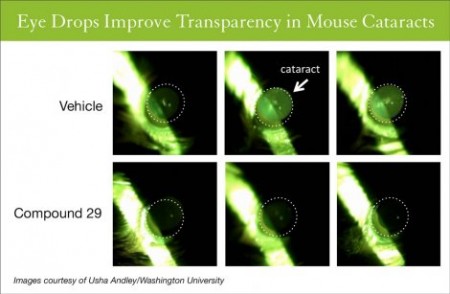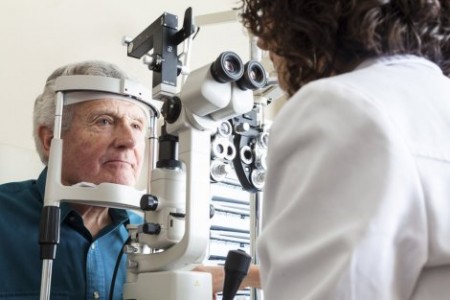November 11, 2015 – Appearing in this month’s edition of the journal Science is an article that reports the discovery of a solution that may prove to be revolutionary in the treatment of cataracts. A team of researchers at University of California San Francisco, University of Michigan and Washington University in St. Louis have collaborated in identifying a compound that when soluble can be turned into eye-drop medication for dissolving cataracts.
Cataracts mostly strike us as we age. About half of individuals over 70 years of age have them. Cataracts are the most common reason for blindness globally.They are caused by proteins called crystallins that are present in the eye from birth. We have a reserve of these proteins that we are born with and no more. The crystallins are responsible for maintaining the transparency of the fiber cells in our lens allowing us to see clearly. But as we age the crystallins may lose equilibrium and begin to fold in unusual ways clumping together to cloud the lens. These clumps are called amyloids and they can eventually block the field of vision.
Finding away to unclump the crystallins was the focus of the research conducted at these three universities. They began looking at 2,450 compounds, narrowed it down to 12, all sterols, and identified one, lanosterol, which they called “Compound 29,” that when injected into the lenses of aged mice dissolved the clumps. Their research showed that the chemical not only dissolved formed amyloids but also stabilized crystallins to prevent them from clumping.
The images below show how treatment with “Compound 29” of genetically predisposed 5-week old mice with cataracts produced dramatic results. Researchers used a protocol involving three applications of the chemical per week for six weeks. In the two image strips, the top one labelled “Vehicle” is the control. The lower strip labelled “Compound 29” shows how the treated eye inhibited amyloid clumps from forming with no evidence of a cataract as a result.
“Compound 29” in eye drop form has also been tested on mice genetically predisposed to cataracts. The results show partial transparency restored where cataracts have formed. In testing on mice with naturally age-related cataracts as well as on human lens tissue surgically removed from patients receiving artificial lens replacement, the eye drops when applied showed measurable improvement in transparency.
“Compound 29” is now being developed commercially in preparation for clinical trials in humans under license to ViewPoint Therapeutics, a California-based company founded by Leah Makley, Chief Scientific Officer, and a Ph.D. graduate from University of Michigan. It has ramifications that go beyond curing human cataracts. Veterinarians are interested in the chemical because 50% of dogs aged 9 or older develop cataracts. And even more interesting is the potential for the chemical in research for cures to Alzheimer’s, Parkinson’s, and Huntington’s Disease. It appears that crystallin proteins found in the eye bear a striking resemblance to those identified with these three neurodegenerative diseases. So an eye drop that can restore vision for patients with cataracts could also lead to new technologies to combat nervous system diseases.
Not too bad!
















